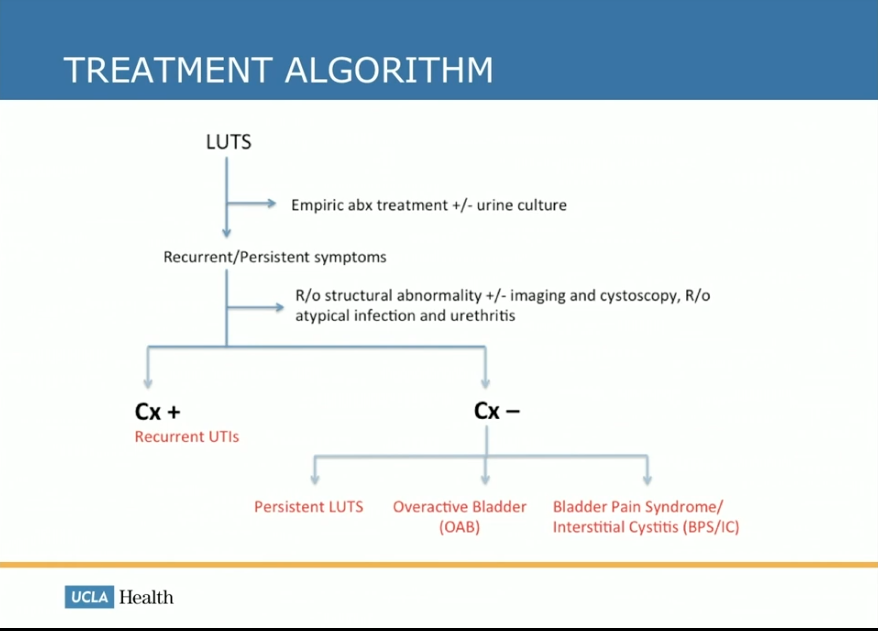Ja-Hong H. Kim, MD, presented “Management of Recurrent UTI in Era of Antimicrobial Resistance” during the 23rd Annual Innovations in Urologic Practice on September 14, 2018 in Santa Fe, New Mexico.
How to cite: Kim, Ja-Hong H. “Management of Recurrent UTI in Era of Antimicrobial Resistance” September 14, 2018. Accessed [date today]. https://dev.grandroundsinurology.com/management-of-recurrent-uti-in-era-of-antimicrobial-resistance/
Management of Recurrent UTI in Era of Antimicrobial Resistance – Summary:
Ja-Hong Kim, MD, discusses the burden of recurrent urinary tract infections (UTIs) and treating patients with antibiotic stewardship during this era of emerging multi-drug resistant pathogens. She then emphasizes UTI prevention through patient education, promoting bladder and vaginal health, and minimizing risk factors.
Recurrent UTI is one of the most common bacterial infections seen in clinical practice. One third of women in the United States will develop a UTI by the time they reach 24. Roughly half of these women will have at least one recurrence within a year. These infections pose a significant socioeconomic impact, costing about 6 billion dollars of national healthcare expenditures. Overall, the impact of UTIs can be burdensome for patients as well as clinicians.
In this era of growing antimicrobial resistance, quality improvement and antibiotic stewardship efforts to optimize recurrent UTI management rely on best practice guidelines and expert recommendations. Risk factors for recurrent UTI include estrogen depletion, defecatory and voiding dysfunction, perineal hygiene, an altered immune system, as well as genitourinary abnormalities. An accurate initial evaluation is essential to maintaining antibiotic stewardship and rule out differential diagnoses, especially interstitial cystitis.
When managing recurrent UTIs, physicians should not solely consider recommended first, second, and tertiary drug and antimicrobial options. It is also important to educate the patient, promote bladder and vaginal health, and minimize risk factors. Additionally, physicians must take special considerations when treating pyelo in regions of escherichia coli (E coli) with resistance to fluoroquinolones and catheter-associated UTIs. Future research should focus on better understanding the urinary microbiome, incorporating rapid diagnostic technology, and improving preventative strategies.
About Innovations in Urologic Practice
Innovations in Urologic Practice (IUP) is an annual CME-accredited conference devoted to updating urologists on the rapidly changing healthcare environment. Topics focus on innovative diagnostic and treatment strategies, controversies, new and currently developing technologies, and challenges in today’s urologic practice. Dr. Kim presented this lecture during the 23rd IUP in 2018. Please visit this page in order to learn more about future IUP meetings.
ABOUT THE AUTHOR
Dr. Kim is an Associate Professor in the Division of Female Pelvic and Reconstructive Surgery in the Department of Urology at UCLA Health in Los Angeles, California. She received her undergraduate and medical degrees from the renowned BA/MD program at Rice University and Baylor College of Medicine, both in Houston, Texas. She completed a Residency in Urology at the Cleveland Clinic Foundation in Cleveland, Ohio, and received a Fellowship in Female Pelvic Medicine and Reconstructive Surgery at UCLA. Dr. Kim’s clinical interests include neurogenic and non-neurogenic voiding dysfunction, interstitial cystitis, benign prostatic hypertrophy, incontinence, neuromodulation for overactive bladder and urinary retention, vaginal prolapse, genitourinary reconstruction, and recurrent urinary tract infections. Dr. Kim has expertise in pelvic floor reconstruction and robotic and laparoscopic surgery. She aims to use these skills to improve patients’ quality of life and to help them regain physical function. Dr. Kim is involved with numerous professional organizations, including the American Urological Association, the Society of Women in Urology, the Society of Urodynamics and Female Urology, and the American Urogynecologic Society. She is also a reviewer for Neurology & Urodynamics, British Journal of Urology, Journal of Urology, and Urology.






